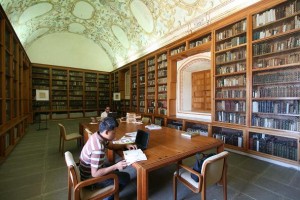On this page we will be assembling materials about this excursion destination, as a way of preparing you for the visit and providing resources for possible use in teaching about codices and manuscript restoration.
The Burgoa Library is an impressive library and archive for rare books and manuscripts, located in a former Dominican monastery adjoining the Santo Domingo church.

(image borrowed from a website)
In 2014, NEH Summer Scholars were allowed to see and browse some rare books, such as guides to herbal remedies and other pieces of significance for ethnobiology.

Restored indigenous-authored pictorials (photo from the display at the Biblioteca Córdova; S. Wood, 2013)

Interview with the manuscript restoration technician, Maestra María del Refugio Gutiérrez Rodríguez at the Burgoa library, having just completed the restoration of a large sixteenth-century codex. (S. Wood, 2009)
The Lienzo de Huilotepec, painted on cotton cloth sometime after 1536 and restored in the Burgoa, includes a genealogy of Zapotec lords in the Tehuantepec area. The first is the lord Cosijopii, who is well known in local history. There is a street named for him a bit west of the Santo Domingo church. His son, Cosijoeza, is also a famous figure locally. Alive to witness the Spanish invasion was the lord don Juan Cortés Cosijopii (born around 1492) — who received the Spanish names “Juan” and “Cortés” through baptism. His son, don Felipe Cortés (many lords who lived in the early Spanish colonial days came to have surnames from famous Spanish invaders), succeeded his father as the ruler of Tehuantepec in 1536. Significantly, those caciques who made alliances with the Spanish invaders retained some measure of local authority, wealth, and status. (This information comes from the sign about the codex that accompanied it on display.)

Restored Lienzo de Huilotepec, 16th-c. pictorial from a Zapotec community southeast of Tehuantepec. (S. Wood, 2009)

The Lienzo de Huilotepec in its glass case with climate control, provided by the Burgoa Library restoration workshop. (S. Wood, 2009)
In 2006 the Maestra María del Refugio (“Cuquita”) demonstrated the restoration of a religious document, as show in the before and after images below.
Below are some fragments of a mass written in the Chontal indigenous language. They were in the process of being restored in 2006.





